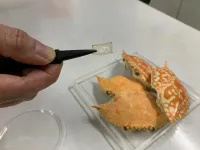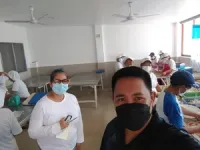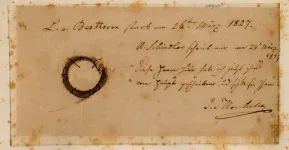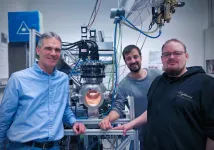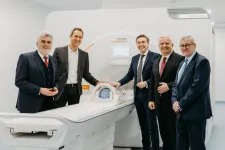(Press-News.org) WASHINGTON — Researchers have developed a process to turn crab shells into a bioplastic that can be used to make optical components known as diffraction gratings. The resulting lightweight, inexpensive gratings are biodegradable and could enable portable spectrometers that are also disposable.
“The Philippines is known for delicious seafood, but this industry is also a source of large amounts of solid waste such as discarded crab shells,” said research team leader Raphael A. Guerrero, from Ateneo de Manila University in the Philippines. “We wanted to find an alternative use for crab shell waste, and decided to find out if chitosan from crab shells could be used as a biodegradable replacement for silicone, which we had previously used in our lab to make diffraction gratings.”
In the Optica Publishing Group journal Applied Optics, the researchers showed that the chitosan-based bioplastic can be used to make diffraction gratings that work just like commercially available ones.
“Gratings made of chitosan are biodegradable and environmentally friendly while also being very inexpensive since crab shells are generally considered waste,” said Guerrero. “By showing that useful optical components can be made from materials typically considered waste, we hope to help improve sustainability in optical manufacturing and reduce the amount of seafood waste that requires disposal.”
Turning crab shells into optics
The researchers decided to explore chitosan due to its promising optical properties. In purified form as a solution, chitosan is transparent and can be molded much like silicone while having a higher refractive index, which is important for certain applications.
To extract chitosan from crab shells, the researchers washed shells that were collected from a local processing plant and dried them in an oven. The shells were then crushed into a powder and turned into a chitosan solution using a chemical process.
The researchers made gratings from the chitosan solution using soft lithography, a replication process that uses a silicone mold to copy the nanoscale surface features of an object. This involved preparing a silicone cast of a commercially available diffraction grating and then pouring the chitosan solution into it. When the solution hardened, it created a replica of the commercial grating.
“Unlike subtractive methods such as laser etching, our soft lithography technique does not create chitosan waste,” said Guerrero. “We can also modify the physical properties of chitosan to better fit a particular need by changing the chemical steps used.”
A diffraction grating has a surface with thousands of microscopic grooves that can split white light into its component colors. When white light was used to illuminate a chitosan grating, the researchers could clearly see the expected rainbow pattern. They also used atomic force microscopy to confirm that the spacing between the grooves of the chitosan grating corresponded to those of the original commercial grating. Finally, tests of the chitosan diffraction gratings with a laser beam produced the correct diffraction patterns.
Single-use spectrometers
“Diffraction gratings are the primary components of spectrometers, instruments used in a variety of industrial and scientific applications to analyze the way that light interacts with a sample to determine its chemical composition,” said Guerrero. “Conventional gratings are typically made of heavy materials such as glass, but gratings made of chitosan could be used to make lighter and less expensive spectrometers.”
The researchers have not yet tested the durability of the chitosan gratings but say that they would be appropriate for disposable spectrometers used for fieldwork. Such an instrument could be used to analyze water pollution in a stream or a food or drug product on the factory floor, for example. Since the material is biodegradable, devices made from chitosan would have minimal impact on the environment. They are also working to improve the power efficiency of the chitosan gratings to make them practical for real-world applications.
“For communities engaged in the crab industry, particularly in the Philippines, our findings add value to their seafood product, since even the waste components could find use in optical manufacturing,” said Guerrero. “With proper collaboration between businesses and the local government, chitosan extracted from crab shells could lead to increased income and a better quality of life for crab fishermen and their families.”
Paper: E. G. Gumayan, I. K. D. Dimzon, R. A. Guerrero, “Chitosan from crab shell waste for soft lithography of bioplastic diffraction gratings,” Applied Optics, vol. 62, issue 10 pp. 2487-2492 (2023).
DOI: https://doi.org/10.1364/AO.483336
About Applied Optics
Applied Optics publishes in-depth peer-reviewed content about applications-centered research in optics. These articles cover research in optical technology, photonics, lasers, information processing, sensing and environmental optics. Applied Optics is published three times per month by Optica Publishing Group and overseen by Editor-in-Chief Gisele Bennett, MEPSS LLC and Georgia Institute of Technology, USA. For more information, visit Applied Optics.
About Optica Publishing Group (formerly OSA)
Optica Publishing Group is a division of Optica, the society progressing light science and technology. It publishes the largest collection of peer-reviewed content in optics and photonics, including 18 prestigious journals, the society’s flagship member magazine, and papers from more than 835 conferences, including 6,500+ associated videos. With over 400,000 journal articles, conference papers and videos to search, discover and access, Optica Publishing Group represents the full range of research in the field from around the globe.
END
Researchers make biodegradable optical components from crab shells
Diffraction gratings made from seafood waste could enable disposable spectrometers that don’t harm the environment
2023-03-22
ELSE PRESS RELEASES FROM THIS DATE:
Beethoven’s genome offers clues to composer’s health and family history
2023-03-22
University of Cambridge Media Release
Beethoven’s genome offers clues to composer’s health and family history
UNDER STRICT EMBARGO UNTIL 11:00 US ET / 15:00 UK / 16:00 CET ON WEDNESDAY 22nd MARCH 2023
International team of scientists deciphers renowned composer’s genome from locks of hair.
Study shows Beethoven was predisposed to liver disease, and infected with Hepatitis B, which – combined with his alcohol consumption – may have contributed to his death.
DNA ...
Ludwig von Beethoven’s genome sheds light on chronic health problems and cause of death
2023-03-22
In 1802, Ludwig van Beethoven asked his brothers to request that his doctor, J.A. Schmidt, describe his malady—his progressive hearing loss—to the world upon his death so that "as far as possible at least the world will be reconciled to me after my death." Now, more than two centuries later, a team of researchers reporting in the journal Current Biology on March 22 have partially fulfilled his wish by analyzing DNA they lifted and pieced together from locks of his hair.
“Our primary goal was to shed light on Beethoven’s health problems, which famously include progressive hearing loss, beginning in his mid- to late-20s and eventually leading to him ...
Unusual Toxoplasma parasite strain killed sea otters and could threaten other marine life
2023-03-22
Scientists in California are raising the alarm about a newly reported form of toxoplasmosis that kills sea otters and could also infect other animals and people. Although toxoplasmosis is common in sea otters and can sometimes be fatal, this unusual strain appears to be capable of rapidly killing healthy adult otters. This rare strain of Toxoplasma hasn’t been detected on the California coast before, and may be a recent arrival, but scientists are concerned that if it contaminates the marine food chain it could potentially pose a public health risk.
“I have studied Toxoplasma infections in sea otters for 25 years — I have never ...
Sea otters killed by unusual parasite strain
2023-03-22
Four sea otters that stranded in California died from an unusually severe form of toxoplasmosis, according to a study from the California Department of Fish and Wildlife and the University of California, Davis. The disease is caused by the microscopic parasite Toxoplasma gondii. Scientists warn that this rare strain, never previously reported in aquatic animals, could pose a health threat to other marine wildlife and humans.
The preliminary findings, published in the journal Frontiers in Marine Science, note that toxoplasmosis is common in sea otters and can be fatal. This unusual strain appears to be especially virulent and capable of rapidly killing healthy adult otters.
The ...
Prevalence of statin use for primary prevention of atherosclerotic cardiovascular disease by race, ethnicity, 10-year disease risk
2023-03-22
About The Study: Statin use for primary prevention of atherosclerotic cardiovascular disease (ASCVD) was low among all race and ethnicity groups regardless of ASCVD risk, with the lowest use occurring among Black and Hispanic adults in this study of survey data representing 39.4 million adults. Improvements in access to care may promote equitable use of primary prevention statins in Black and Hispanic adults.
Authors: Joshua A. Jacobs, Pharm.D., of the Spencer Fox Eccles University of Utah School of Medicine in Salt Lake City, and Ambarish Pandey, M.D., of the University of Texas Southwestern Medical Center in Dallas, are the corresponding authors.
To ...
Cost-effectiveness of mailed home-based HPV self-sampling kits for cervical cancer screening
2023-03-22
About The Study: In this analysis involving 19,000 female participants, mailing human papillomavirus (HPV) self-sampling kits to women overdue for cervical cancer screening was cost-effective for increased screening uptake relative to usual care. These results support mailing HPV kits as an efficient outreach strategy for increasing screening rates among eligible women in U.S. health care systems.
Authors: Richard T. Meenan, Ph.D., M.P.H., M.B.A., of Kaiser Permanente Northwest in Portland, Oregon, is the corresponding author.
To access the embargoed study: Visit our For The Media website at this link ...
Sweets change our brain
2023-03-22
Chocolate bars, crisps and fries - why can't we just ignore them in the supermarket? Researchers at the Max Planck Institute for Metabolism Research in Cologne, in collaboration with Yale University, have now shown that foods with a high fat and sugar content change our brain: If we regularly eat even small amounts of them, the brain learns to consume precisely these foods in the future.
Why do we like unhealthy and fattening foods so much? How does this preference develop in the brain? "Our tendency to eat high-fat and high-sugar foods, the so-called Western diet, could be innate or develop as a result of being overweight. But we think that the brain learns this preference," ...
Study determines most effective ways for hospitals to reduce medication errors
2023-03-22
A new study from researchers from Brigham and Women’s Hospital, a founding member of the Mass General Brigham healthcare system, has shed new light on the best strategies hospitals can use for medication reconciliation, the critical and difficult task of updating and verifying a patient’s medication lists and orders, regardless of where they are in the health care system. The study, published in BMJ Quality and Safety, is a new analysis of data from the second Multi-center Medication Reconciliation ...
New invention: The oxygen-ion battery
2023-03-22
Lithium-ion batteries are ubiquitous today - from electric cars to smartphones. But that does not mean that they are the best solution for all areas of application. TU Wien has now succeeded in developing an oxygen-ion battery that has some important advantages. Although it does not allow for quite as high energy densities as the lithium-ion battery, its storage capacity does not decrease irrevocably over time: it can be regenerated and thus may enable an extremely long service life.
In addition, oxygen-ion batteries can be ...
Europe’s most powerful 7-tesla MRI machine in operation
2023-03-22
On Wednesday, 22 March 2023, at Otto von Guericke University Magdeburg, Europe’s most powerful 7-Tesla magnetic resonance imaging (MRI) machine was formally inaugurated. The symbolic push of the button to start the high-performance MRI machine for future research work took place in the presence of the Minister of Science for Saxony-Anhalt, Prof. Dr. Armin Willingmann.
Henceforth, the MAGNETOM Terra.X Impulse Edition will enable brain functions and structures to be mapped and measured on site with a previously unachievable level of precision. “With ...
LAST 30 PRESS RELEASES:
The Ceramic Society of Japan’s Oxoate Ceramics Research Association launches new international book project
Heart-brain connection: international study reveals the role of the vagus nerve in keeping the heart young
Researchers identify Rb1 as a predictive biomarker for a new therapeutic strategy in some breast cancers
Survey reveals ethical gaps slowing AI adoption in pediatric surgery
Stimulant ADHD medications work differently than thought
AI overestimates how smart people are, according to HSE economists
HSE researchers create genome-wide map of quadruplexes
Scientists boost cell "powerhouses" to burn more calories
Automatic label checking: The missing step in making reliable medical AI
Low daily alcohol intake linked to 50% heightened mouth cancer risk in India
American Meteorological Society announces Rick Spinrad as 2026 President-Elect
Biomass-based carbon capture spotlighted in newly released global climate webinar recording
Illuminating invisible nano pollutants: advanced bioimaging tracks the full journey of emerging nanoscale contaminants in living systems
How does age affect recovery from spinal cord injury?
Novel AI tool offers prognosis for patients with head and neck cancer
Fathers’ microplastic exposure tied to their children’s metabolic problems
Research validates laboratory model for studying high-grade serous ovarian cancer
SIR 2026 delivers transformative breakthroughs in minimally invasive medicine to improve patient care
Stem Cell Reports most downloaded papers of 2025 highlight the breadth and impact of stem cell research
Oxford-led study estimates NHS spends around 3% of its primary and secondary care budget on the health impacts of heat and cold in England
A researcher’s long quest leads to a smart composite breakthrough
Urban wild bees act as “microbial sensors” of city health.
New study finds where you live affects recovery after a hip fracture
Forecasting the impact of fully automated vehicle adoption on US road traffic injuries
Alcohol-related hospitalizations from 2016 to 2022
Semaglutide and hospitalizations in patients with obesity and established cardiovascular disease
Researchers ‘listen in’ to embryo-mother interactions during implantation using a culture system replicating the womb lining
How changing your diet could help save the world
How to make AI truly scalable and reliable for real-time traffic assignment?
Beyond fragmented markets: A new framework for efficient and stable ride-pooling
[Press-News.org] Researchers make biodegradable optical components from crab shellsDiffraction gratings made from seafood waste could enable disposable spectrometers that don’t harm the environment
